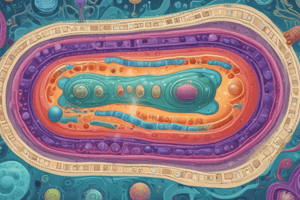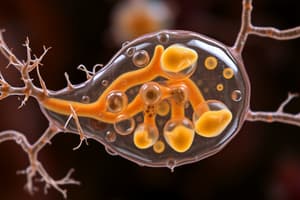Podcast
Questions and Answers
What percentage of bacteria and archaea are unculturable?
What percentage of bacteria and archaea are unculturable?
- 70%
- 20%
- 30%
- 50% (correct)
What recent development has enabled the study of entire prokaryotic communities in their natural habitats?
What recent development has enabled the study of entire prokaryotic communities in their natural habitats?
- Microscopy
- Lab simulation
- Culturing techniques
- Large-scale DNA sequencing (correct)
What is a key challenge posed by prokaryotic life?
What is a key challenge posed by prokaryotic life?
- Antibiotic resistance (correct)
- Climate change
- Viruses
- Ecological balance
What is similar between prokaryotes and eukaryotes?
What is similar between prokaryotes and eukaryotes?
Where can prokaryotes be found?
Where can prokaryotes be found?
Why is understanding prokaryotic organelles and their functions important?
Why is understanding prokaryotic organelles and their functions important?
What is a characteristic of prokaryotic cells?
What is a characteristic of prokaryotic cells?
What is the function of fimbriae in prokaryotic cells?
What is the function of fimbriae in prokaryotic cells?
What is the composition of the cell wall in bacteria?
What is the composition of the cell wall in bacteria?
What is a function of flagella in prokaryotic cells?
What is a function of flagella in prokaryotic cells?
What is the shape of the chromosome in most prokaryotic cells?
What is the shape of the chromosome in most prokaryotic cells?
What is a function of pili in prokaryotic cells?
What is a function of pili in prokaryotic cells?
Study Notes
Prokaryotes are single-celled organisms belonging to the domains Bacteria and Archaea. They are much smaller than eukaryotic cells, have no nucleus, and lack organelles as we understand them in eukaryotic cells. However, recent research has shown that prokaryotes are not as simple as previously thought. They contain membrane-bounded organelles such as magnetosomes, chromatophores, and pirellulosomes, whose formation and dynamics are precisely regulated.
Prokaryotic cells are encased by a cell wall, which is composed of peptidoglycan in bacteria and pseudopeptidoglycan in archaea. Many prokaryotes also have a capsule or slime layer made of polysaccharide. Prokaryotes often have appendages (protrusions) on their surface. Flagella and some pili are used for locomotion. Fimbriae help the cell stick to a surface, and sex pili are used for DNA exchange.
Most prokaryotic cells have a single circular chromosome. They may also have smaller pieces of circular DNA called plasmids, which can be transferred between cells and are often associated with antibiotic resistance.
Prokaryotic cells have a simpler structure than eukaryotic cells. They lack many of the complex organelles found in eukaryotic cells, such as mitochondria, chloroplasts, and the endoplasmic reticulum. However, prokaryotes have their own unique set of challenges and have evolved mechanisms to address these challenges.
The classification and diversity of prokaryotes are vast. Prokaryotes, which include both bacteria and archaea, are found almost everywhere – in every ecosystem, on every surface of our homes, and inside of our bodies. An estimated 50% of bacteria and archaea are unculturable, meaning they cannot be grown in a laboratory setting. This presents a challenge for understanding the full range of prokaryotic species and their functions.
Recent advances in DNA sequencing have opened up a new window into the world of prokaryotes. Large-scale DNA sequencing has made it possible to study entire prokaryotic communities in their natural habitats, including the many prokaryotes that are unculturable. This has led to a better understanding of the diversity and complexity of prokaryotic life.
In conclusion, prokaryotes are more complex than previously thought, with a range of organelles and systems that are similar to those found in eukaryotes. Understanding these organelles and their functions is crucial for understanding the evolution of cellular life and for addressing the challenges posed by antibiotic resistance and other issues related to prokaryotic life.
Studying That Suits You
Use AI to generate personalized quizzes and flashcards to suit your learning preferences.
Description
Learn about the unique characteristics and features of prokaryotic cells, including their size, structure, and functions. Discover the similarities and differences between prokaryotes and eukaryotes, and explore the diversity of prokaryotic life. This quiz covers the basics of prokaryotic cells, including their organelles, DNA, and evolution.




